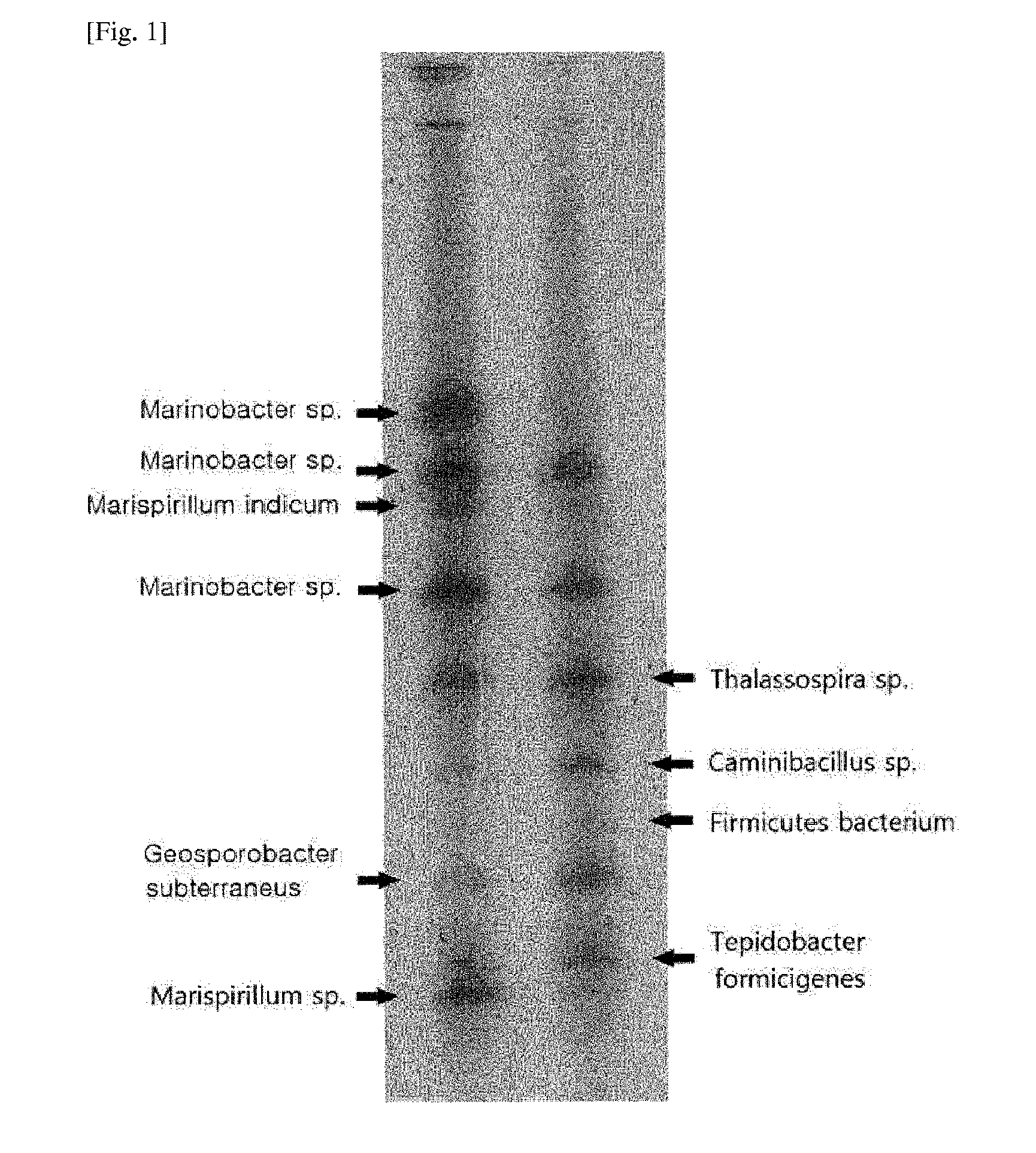Method for removing nitrate from solution comprising salt component
a technology of salt and nitrate, which is applied in the field of removing nitrate from salt solution, can solve the problems of not being able to prepare salt with less nitrate, nitrate giving harmful effects on the survival of marine fishes, and nitrate being known as a risk factor of various diseases, so as to reduce the consumption of sodium and strengthen the taste of sal
- Summary
- Abstract
- Description
- Claims
- Application Information
AI Technical Summary
Benefits of technology
Problems solved by technology
Method used
Image
Examples
first embodiment
alt Without Nitrate (Sulfur Reducing Bacteria is Used)
[0112]10 L salt water of 9% salinity containing nitrate is poured in a cylinder-shaped container. Roots of Sasa borealis are but into pieces of 1 cm to 2 cm, and sulfur reducing bacteria (LSM of Carbi Sea company is purchased and extracted; the bacteria name is sulfur reducing bacteria, “Desulfuromonas”) is transplanted. And the bacteria-transplanted roots of Sasa borealis are filled from the bottom of the cylinder-shaped container to the surface of the water. Temperature is maintained at normal temperatures, and the container is covered with a lid to block the external air. The concentration of the nitrate was measured after 6 days from the starting date, and it was confirmed that the concentration of nitrate was 0 mg / L and the Sasa borealis pieces were taken out from the cylinder-shaped container. The remaining salt water was filtered and was then poured in a separate container to prepare salt water without nitrate.
[0113]As che...
second embodiment
lt Water without Nitrate
[0114](1) Extracting Bacteria from Salt Water in a Salt Farm
[0115]1) Method of Directly Transplanting Bacteria in a Plant to be Used
[0116]A plant (root pieces of Sasa borealis) containing sulfur which has been cut into pieces of 1 to 2 cm is put in the salt water of 9% salinity from a salt farm of Sinan area of West Sea of Korea, and it is then matured in the range of 20 to 35° C. for three days so as to transplant bacteria in Sasa borealis.
[0117]2) Method of Preparing Bacteria Transplanted Pieces by Using a Separate Plant
[0118]Transplanted pieces (root pieces of Sasa borealis) which have been cut into pieces of 1 to 2 cm are put in the salt water of 9% salinity from a salt farm of Sinan area of West Sea of Korea, and they are then matured in the range of 20 to 35° C. for 15 days so as to transplant and proliferate sulfation bacteria in Sasa borealis.
[0119](2) Removing Nitrate from Salt Water (Sulfation Bacteria, etc. are Used)
[0120]A glass container of 180...
third embodiment
itrate-Minimized Salt
[0126]Salt water, which is prepared in no. 1 (bamboo shoot is used as the plant containing edible sulfur) of the second embodiment, is heated to 90 to 100° C., and water is evaporated within 2 minutes so as to prepare fine salt. In order to measure the amount of nitrate contained in the prepared salt, prepared salt 1 g is melted in distilled water 300 ml, and then the content of nitrate was measured by using Test No. 3 measuring kit of Tetra company (Germany, www.tetra.net) As a result, the content of nitrate was 1.3 mg / 100 g.
PUM
 Login to View More
Login to View More Abstract
Description
Claims
Application Information
 Login to View More
Login to View More - R&D
- Intellectual Property
- Life Sciences
- Materials
- Tech Scout
- Unparalleled Data Quality
- Higher Quality Content
- 60% Fewer Hallucinations
Browse by: Latest US Patents, China's latest patents, Technical Efficacy Thesaurus, Application Domain, Technology Topic, Popular Technical Reports.
© 2025 PatSnap. All rights reserved.Legal|Privacy policy|Modern Slavery Act Transparency Statement|Sitemap|About US| Contact US: help@patsnap.com

